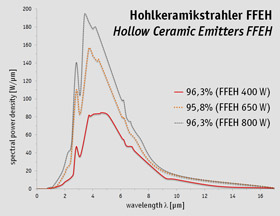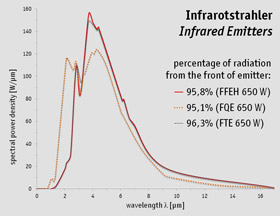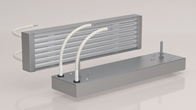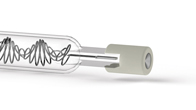There are three main types of infrared emitters. They are classified according to emitted wave lengths:
- long wave emitters, peak wave length 3 - 7 µm (e. g. ceramic emitters)
- medium wave emitters, peak wave length 3 - 5,5 µm (e. g. quartz cassettes)
- short wave emitters, peak wave length 1 - 1,6 µm (e. g. quartz-halogen-emitters)
The warmer the emitting body - the shorter-wave the radiation. And vice-versa: the more short wave the radiation, the higher the percentage of light. Our long wave ceramic heaters achieve max. 680 °C at the emitter surface and thus emit hardly any light. Our quartz halogen emitters on the other hand are very bright and correspondingly hot, at more than 2500 °C.
Which emitter type is the best for your application depends on many factors. For most applications an optimum match of emitted wave length and absorption of the target material is desirable. This means a highly efficient transfer of radiation energy in the material and thus a very quick heating. However, there are exceptions to the rule. At very high required energy densities, cyclical processes, transparent, thin or low-conductive materials it might be necessary under certain circumstances to deliberately use emitters whose characteristics deviate radically from the absorption characteristics of the material to be processed. Finally, in many applications, including thermoforming, all three basic emitter types are successfully used – long wave ceramic emitters, medium wave quartz emitters and short wave halogen emitters. This also serves to show that using the appropriate regulatory and control technology is also a crucial factor - in addition to the correct matching of emitter and material. In fact and in most cases an inappropriate or wrongly programmed process control method is the obstacle that stands in the way of the required process and product quality.
In addition to energy efficiency and process speed there are pragmatic criteria that have to be considered when choosing the right kind of emitter: Ceramic emitters are quite robust and can also be used in dusty surroundings. Due to their overall mass they react quite slowly. However, they emit a wide infrared spectrum, so that they can be used as "all-purpose tool". For shorter heating times and high energy densities the quartz halogen emitters are clearly superior to the ceramic emitters. On the other hand they are more fragile and susceptible for contamination as the medium wave quartz elements.
 One more thing regarding radiation power: This does not necessarily increase proportionally to the electric emitter power. As you can see in the a.m.
spectral analysis of a ceramic hollow emitter (FFEH) at higher power and thus higher emitted temperatures the peak wave length (wave length maximum)
moves towards shorter wave lengths. This changes the emission characteristic and therefore the energy efficiency of the infrared-heating.
One more thing regarding radiation power: This does not necessarily increase proportionally to the electric emitter power. As you can see in the a.m.
spectral analysis of a ceramic hollow emitter (FFEH) at higher power and thus higher emitted temperatures the peak wave length (wave length maximum)
moves towards shorter wave lengths. This changes the emission characteristic and therefore the energy efficiency of the infrared-heating.
In order to facilitate your choice of product, please find below a comparison of important characteristics of the three main emitter types:
Long Wave Ceramic Infrared Emitters
- Usable emitted wave length: 2 - 10 µm
- Heating time (T85%): 4 - 7 minutes
- Integrated thermocouple possible: yes
- Certificates: mostly UL
- Special sizes possible: no
Medium Wave Quartz Emitters
- Usable emitted wave length: 1,5 - 8 µm
- Heating time (T85%): 4 - 6 minutes
- Integrated thermocouple possible: yes
- Certificates: partially UL
- Special sizes possible: no
Short Wave Quartz Emitters
- Usable emitted wave length: 1 - 6,5 µm
- Heating time (T85%): few seconds
- Integrated thermocouple possible: no
- Certificates: none
- Special sizes possible: yes
Restrictions for infrared emitters:
Not all surfaces and materials can be heated with infrared. Brightly shining metallic surfaces are problematic. Polished aluminum for
example has a reflection value of 0.9, i.e. 90% of the radiation is reflected and only 10% is absorbed or transmitted. An appropriate
coating or lacquering can provide a solution. Very thin materials (thinner than 0.1 mm) and/or transparent materials also pose particular
challenges...which we can solve – just contact us!
You can find detailed selection support in our service chapter including highly interesting research reports in the field of IR research.
Descargas:
-
Flyer - Looking for contactless heating?

Freek offers long-wave, medium-wave und short-wave infrared emitters!
-
Really hot! Our Product Flyer.

Download our leaflet here.










